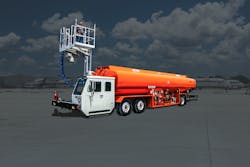A Customizable Fueling Experience
When it comes to refueling, various airports have unique requirements. That is why Westmor focuses on customization when designing equipment, including their 10,000-gallon refueler truck.
The 10,000-gallon refueler is designed to service jet-powered aircraft.
“With the lift deck it can even reach the fueling panel of the Airbus A380,” says Pete Buffkin, Westmor’s aviation sales manager. “And with the addition of an overwing reel, it can fuel aircraft that don’t accept a single point nozzle. Much like our other products, we can customize it based on our customer’s operational needs.”
The truck, which is currently in use at major Canadian airports and by the U.S. military, can refuel aircraft at rates up to 800 gallons per minute (GPM).
“The engine is mounted in the rear to provide adequate distance from the fueling operation and has a hydrostatic pump drive system,” says Mandi Carlberg, Westmor’s marketing communications manager. “The 10,000-gallon refueler is built in compliance with ATA-103, NFPA 407, NIST Handbook 44 and DOT 406 requirements.”
In addition to being fully customizable, Westmor aims to provide equipment that requires nominal maintenance.
“This unit is built on a chassis that is designed for the refueling application. It is rugged, durable and simple without excessive features that are designed into the over-the-road chassis. It is designed to keep maintenance minimal and simple, just like the tank and refueling system,” Buffkin says.
Because changes in the aviation industry are often driven by regulatory updates, Carlberg says Westmor generally makes alterations to its refuelers on a customer-by-customer basis in order to provide as much customization as possible.
“We are able to build any mix of products required,” Carlberg says.
For example, the 10,000-gallon refueler can feature bottom loading, a lift deck, multiple primary and secondary pressure control configurations, air or electric deadman controls without time delays, tank top fall protection systems, stainless steel piping, primary and secondary high-level shutdown systems, Camlock dust caps, back-up alarms, back-up cameras, one- or two-man cabs and wing protection on the lift deck. Additionally, it can feature multiple meter options, including electronic meter registration and wireless data transmission.
“The features and options are almost endless,” Carlberg adds.
Because of the wide array of airport refueling needs, Westmor also makes several sizes of refueler trucks, which can vary from 1,000 to 10,000 gallons.
The size of the refueler depends on the needs of the operation and the type of aircraft being refueled. Westmor’s 10,000-gallon refueler, specifically, was designed for large upfits off the hydrant, generally for commercial aviation — including large cargo aircraft.
“Larger refuelers tend to be [for] larger operations or more of a commercial aviation customer that would be refueling large jets,” says Carlberg, adding lower capacity refuelers are generally used for smaller operations or an FBO.
Westmor’s smallest refuelers tend to carry Avgas whereas their larger refuelers are used for jet fuel.
When customizing a refueler, Buffkin says ground service providers should consider what they are going to use the unit for.
For example, if the unit is going to be used for commercial aircraft off a hydrant system, customers will need to consider how much fuel they need to provide without refilling the tank, what their flow rate needs to be, where the fueling panel is on the aircraft and if defueling will need to be performed.
“Probably the biggest consideration is how the operation needs to get data from the fueling operation,” Buffkin says. “There are a multitude of electronic meters available today that can eliminate some of the human error of transferring data to the operation.”
Even if the operation does not currently use any type of data acquisition, the refueling equipment can be specified with systems that can adapt to them later.
“By selecting the proper equipment, fuel service providers can provide the best service to their customers,” Buffkin says. “With equipment that is tailored to your operation, whether it’s an into-plane operation, an FBO or a corporate flight department, fueling can be smooth and efficient so your customer can be taken care of with the highest level of service.”
Other factors — geographic location, climate and traffic volume, for example — will influence a ground handler’s purchase decision as well.
“Particularly cold climates will want cold weather hoses and to reduce the amount of air controls on a refueler,” Buffkin said. “Salt air climates such as in the Caribbean will require extra corrosion protection. Traffic volume and size of aircraft will dictate the size and flow rate of the refueling equipment needed.”
Because Westmor is located in Minnesota, Carlberg says Westmor is known for its ability to build cold-weather equipment.
“But our years in the business have taught us how to design and build equipment for every environment,” Carlberg adds.
Because of the lifespan of fueling equipment, Buffkin says it is important to select the right unit to make an operation run efficiently and have a piece of equipment that is simple to maintain.
“Documents such as ATA-103 and JIG 1 provide the best guidelines for keeping the fueling systems in good operating condition, and the chassis maintenance manuals are a great resource for that part of the equipment,” Buffkin says in regards to the 10,000-gallon refueler's regular maintenance needs.
However, Buffkin notes, the most important aspect of maintenance is training operators to pay attention to the equipment every time it is used. He explains it is imperative to identify small issues before they turn into big problems.
